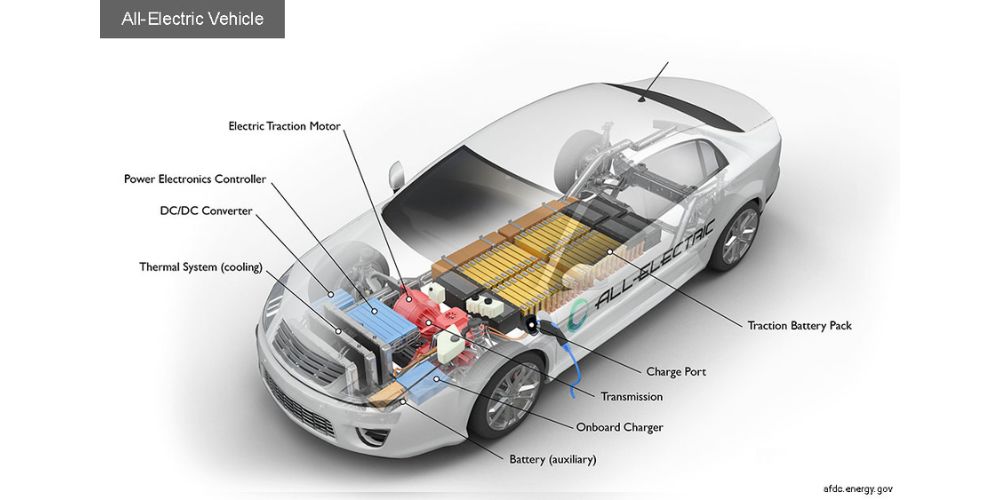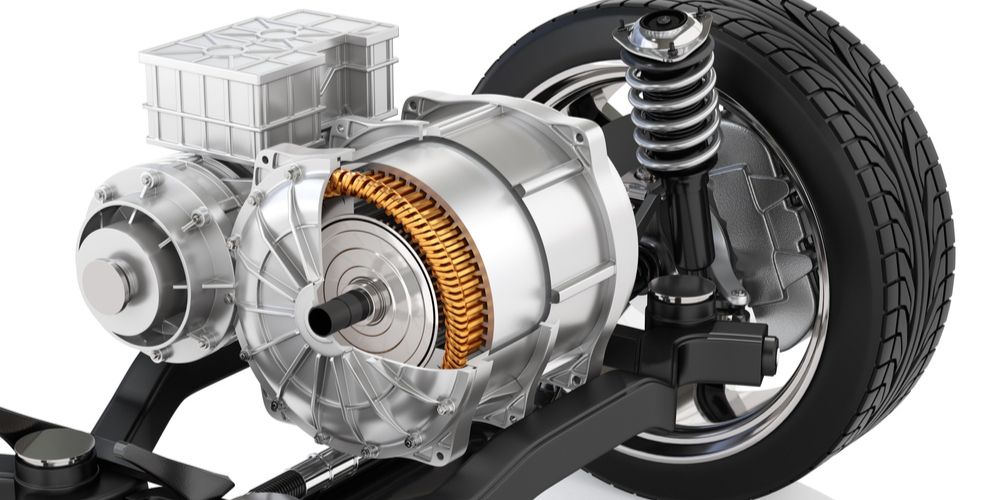In recent posts we’ve looked at the ins and outs of charging electric vehicles, how much greener they are than internal combustion engine equivalents, and the top five EVs for charge time. But how does an electric car actually work? If you’ve ever wanted to know, this is the post for you.
What are the main parts in electric vehicles?
The first step to understanding how electric cars work is getting a sense of the different parts that make up an electric vehicle.
The image below shows the key elements of an EV.

Image credit: AFDC Energy
- Battery (auxiliary): Provides power to the vehicle
- Charge port: For plugging in a power supply
- DC/DC converter: Converts the traction pack’s high-voltage current to lower-voltage DC power that runs the vehicle and recharges the aux battery
- Electric traction motor: Drives the wheels using power from the traction battery pack
- Onboard charger: Converts AC power from the charge port into DC power to charge the traction battery. Also monitors and communicates the batteries charge state during charging.
- Power electronics controller: Manages the flow of energy and controls the speed of the traction motor
- Thermal system: Cools the engine, electric motor and other components
- Traction battery pack: Stores power used by the traction motor, including power converted from braking
- Transmission (electric): Drives the wheels using power produced by the traction motor.
Everything to know about how electric cars work
How does an electric car move its wheels?

If you’ve ever wondered ‘how does an electric car motor work?’ we’ll answer that here.
The basic principle is similar to an ICE motor in that each uses power of a certain kind to generate rotational force, which propels the car forward. However, combustion engines use pressurised air and fuel to cause tiny explosions that drive pistons, causing a mechanical crankshaft to whirr into life.
An EV instead has a motor packed with electromagnets. The vehicle’s inverter module draws power from the battery and effectively reverses the polarity of the current around sixty times a second. This causes the motor’s magnets to spin, enabling the car to move.
The upshot is that the motion created by an EV is already rotary in nature – unlike an ICE motor, which needs the aforementioned crank shaft. This is one of many reasons why electric motors are more reliable than combustion engines, and why EVs as a whole tend to need far less maintenance than petrol and diesel vehicles.
How does braking charge the battery?
Another clever aspect of how electric cars work is that they can actually convert the friction produced during braking into electrical energy that helps power propulsion.
The video below from Porsche shows how the Taycan (one of the five fastest-charging EV models currently available anywhere in the world) uses regenerative braking to capture the kinetic energy produced by braking and feeds it back into the car’s battery.
While regenerative braking won’t fully charge a battery, it does serve to add extra distance to your journey before you need to charge the vehicle – a feature that can be used as a way to win over doubters in your fleet if and when they come to you with concerns around EV range anxiety.
What is it like driving an EV?
So far we’ve established some of the basics behind how electric cars work, but what kind of experience does all that technology create for drivers? Most notably, are electric cars actually a viable alternative to petrol and diesel vehicles in the here and now?
Just a look at some of the statistics might surprise you:
- The average EV range in the UK is around 260 miles
- The average rapid charge time for vehicles is between 20-30 minutes for anywhere from 60-200 miles of range.
- There are now over EV 42,000 charge points in the UK at over 15,500 locations – more than the number of petrol stations!
The upshot is that city drivers and short-medium distance commuters can conceivably replace their petrol or diesel vehicle in 2022 with an EV and, assuming they charge it regularly overnight to 100% as recommended, are unlikely to feel much (if any) difference – other than an increase in their spending money thanks to the lower fuel costs of electric fuel.
For those who regularly drive longer distances, the differences may be more pronounced – particularly waiting 20-30 minutes to rapid charge vs 2-3 minutes filling up at a petrol station. However, it’s important to remember that filling up on longer drives typically happens at motorway service stations, where a 20-30-minute comfort and lunch break is somewhat typical. So even for longer drives, how electric cars work is likely to cause far less issues than you might expect.
Looking to go electric?
So that’s our post explaining (almost) everything to know about how electric cars work – and, more importantly, what that currently means for modern EV drivers.
If you’re thinking of making your next business car lease an electric one, or you’re considering switching your whole fleet to a greener option, we can help.
Get in touch with our team to discuss your needs and start getting a feel for the best electric vehicle (or vehicles!) for you.







